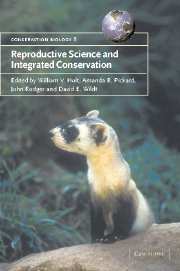Book contents
- Frontmatter
- Contents
- List of contributors
- Foreword
- Part I Introduction
- Part II Reproduction and population viability
- Part III Reproductive techniques for conservation management
- Part IV Integrated conservation management
- 14 Integrating reproductive sciences into recovery programmes for declining and extinct marsupial populations
- 15 Captive breeding and predator control: a successful strategy for conservation in Western Australia
- 16 Black-footed ferret: model for assisted reproductive technologies contributing to in situ conservation
- 17 Genetic resource banks for species conservation
- 18 Fertility control for wildlife
- 19 Contraceptive vaccine development
- 20 Field applications of fertility control for wildlife management
- Part V Reproduction science in non-mammalian species
- Part VI Conclusions
- Index
- References
17 - Genetic resource banks for species conservation
Published online by Cambridge University Press: 21 January 2010
- Frontmatter
- Contents
- List of contributors
- Foreword
- Part I Introduction
- Part II Reproduction and population viability
- Part III Reproductive techniques for conservation management
- Part IV Integrated conservation management
- 14 Integrating reproductive sciences into recovery programmes for declining and extinct marsupial populations
- 15 Captive breeding and predator control: a successful strategy for conservation in Western Australia
- 16 Black-footed ferret: model for assisted reproductive technologies contributing to in situ conservation
- 17 Genetic resource banks for species conservation
- 18 Fertility control for wildlife
- 19 Contraceptive vaccine development
- 20 Field applications of fertility control for wildlife management
- Part V Reproduction science in non-mammalian species
- Part VI Conclusions
- Index
- References
Summary
INTRODUCTION AND BACKGROUND
Genetic resource banking (GRB) provides potentially useful support for managing and conserving wildlife species. The GRB concept and strategies have received increasing attention over the last two decades (Holt et al., 1996b; Wildt et al., 1997; Holt & Pickard, 1999; Watson & Holt, 2001). This chapter summarises the general ideas presented in these earlier works while outlining new developments and providing examples of how GRBs are being applied to particular species. Specifically, we endeavour to provide a realistic evaluation of the current utility of GRBs, illustrating how to integrate the logistics of the technology into practical conservation programmes.
In terms of focus, this chapter is concerned with wild animal GRBs which are defined as organised collections of stored germplasm, mainly cryopreserved spermatozoa from individuals whose contribution to the gene pool is too valuable to lose. This definition helps to distinguish GRBs from other collections of frozen, dried or fixed biomaterials. Although a useful research resource, such collections have until recently had little practical value in breeding programmes. The GRB discussed here also differs from ad hoc collections of germplasm amassed opportunistically over time. By nature such collections are unplanned, containing random assortments of species and individuals. In contrast, a useful GRB is preplanned in some detail, addressing a wide range of organisational issues, from mundane specimen labelling to safe stewardship, to the politics of proprietary rights.
- Type
- Chapter
- Information
- Reproductive Science and Integrated Conservation , pp. 267 - 280Publisher: Cambridge University PressPrint publication year: 2002
References
- 3
- Cited by



